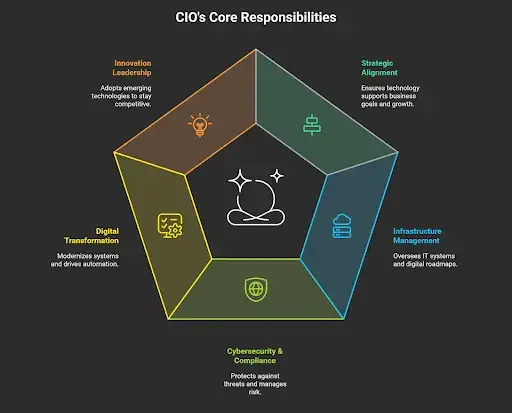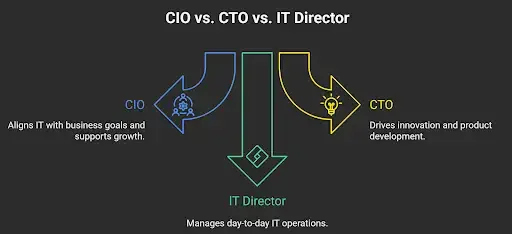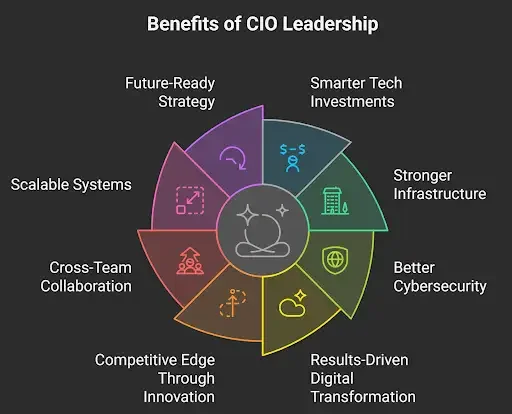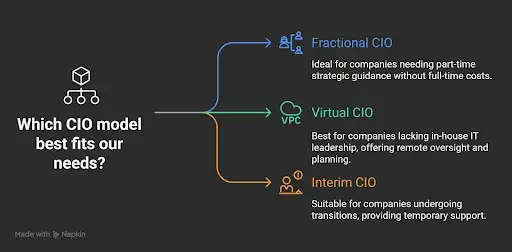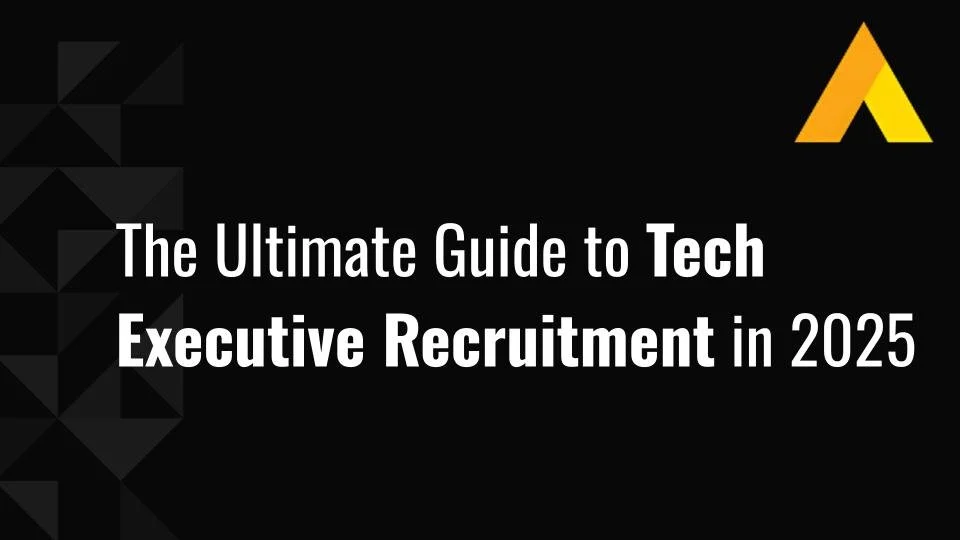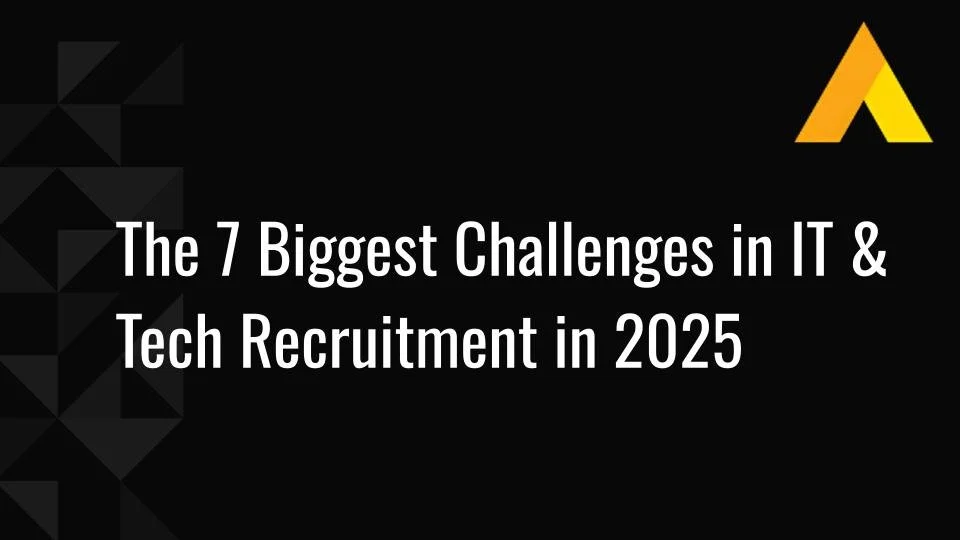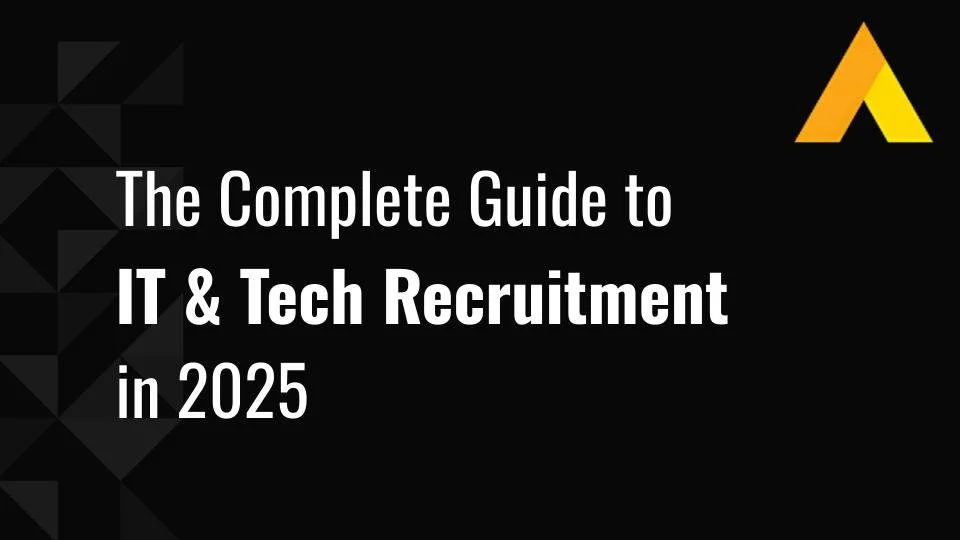Why Hire a CIO: Signs, Reasons, and Benefits
Technology now drives growth across every sector. As companies expand, the question of why hire a CIO moves from optional to urgent, because aligning IT with business goals can make or break scale.
A Chief Information Officer (CIO) is the bridge between where your business is going and how your tech supports that journey. This matters if you’re a mid-sized company feeling growing pains, or a startup scaling fast and needing stronger systems.
Next, we’ll walk through what a CIO really does, how to know when you need one, why they’re different from a CTO or IT manager, and the real-world value they bring to the table. Let’s get into it.
Pro Tip: Planning a tech leadership hire? Explore our executive recruitment guide for practical steps on when to hire, how to define the role, and what to prioritize in senior tech talent.
TL;DR
No time to read it all? Start with this:
A CIO connects business goals with technology decisions, leading IT strategy, operations, and digital transformation.
Key signs you need one: fast growth, disorganized systems, security gaps, and unclear tech direction.
CIOs go beyond a CTO or IT Director, bringing long-term vision, cross-team alignment, and measurable ROI.
Top benefits: better tech investments, lower risk, improved efficiency, and future-ready systems.
Not ready for full-time? Virtual or fractional CIOs give you senior leadership without the overhead.
Start by clarifying your business priorities, current tech pain points, and growth plans.
And when you’re ready to hire, look for someone who blends tech depth with business strategy and clear communication.
What Does a CIO Actually Do?
CIOs do far more than manage infrastructure or troubleshoot tech issues. Their true role is to support business growth by ensuring technology is aligned, secure, and prepared for what’s ahead.
They’re responsible for selecting the right tools, connecting systems efficiently, and ensuring that data and operations run reliably. That’s why 50% of the CIOs identify as business leaders first, using technology as a driver for progress.
Here’s a closer look at what that actually involves:
Key Responsibilities of a CIO
Here’s what they actually handle:
Aligning technology with business goals: The CIO ensures that every system, platform, and tool directly supports the organization’s growth strategy. Business priorities and long-term value guide technology decisions.
Owning IT infrastructure and digital strategy: The CIO decides what to build, buy, or retire. Every choice (cloud platforms, integrations, or system upgrades) has to serve the company’s broader vision.
Protecting the business from cyber threats: As cybersecurity threats become more complex, the CIO leads efforts in defense, compliance, and risk management to keep the organization secure.
Leading digital transformation: In 26% of companies, the CIO holds sole responsibility for all digital transformation decisions and initiatives. That includes modernizing legacy systems, driving automation, and ensuring every initiative supports long-term growth.
Driving innovation from the top: CIOs are at the forefront of adopting emerging technologies such as AI, machine learning, and advanced cloud solutions. Currently, 80% of IT leaders report leading their organization’s AI strategy.
Real World Example of a CIO in Action
James Ross, CIO of Global Functions at General Electric, played a key role in driving a massive digital transformation for the company. At GE, this meant embedding sensors into operations and capturing performance data. Beyond improving internal systems, those insights powered a new generation of smarter, data-driven products.
Ross also highlights the real impact of a CIO. In his words:
“Spend as much time as you can understanding how the business works and how digital transformation will help the business work even better.”
This is a great example of how a CIO can lead not just tech improvements, but full-on business innovation.
Pro Tip: Not sure what makes a truly effective CIO? Check out these 10 unmistakable traits of a great CIO to know exactly what to look for.
Why Hire a CIO (Instead of “Just” a CTO or IT Manager)?
A lot of companies assume a CTO or IT Manager can cover the same ground. But here’s the truth: while all three roles are valuable, only one is designed to lead tech with a business-first mindset.
Let’s see why:
Understanding the Differences: CIO vs. CTO vs. IT Director
A lot of companies mix up the CIO role with a CTO or an IT Director. But the truth is, each one plays a very different role:
CIO (Chief Information Officer)
While others might manage tech, the CIO connects it directly to business growth. Their strength lies in aligning technology with the company’s long-term goals: scaling, digital transformation, or entering new markets.
Working alongside the executive team, they guide strategy and ensure every investment in technology pushes the business forward.
CTO (Chief Technology Officer)
Focused on innovation and product development, the CTO typically owns customer-facing technology. This role is more common in product-led companies or startups, where the tech is the product. CTOs experiment, prototype, and help bring new features or platforms to market.
IT Director
This is your day-to-day operations lead. IT Directors keep everything running, like managing support tickets, internal tools, software licenses, and system uptime. It’s a critical role for maintaining efficiency, but it’s more tactical than strategic.
Compared to a CTO or IT Director, the CIO’s influence extends beyond systems and products. They’re the ones aligning tech with the company’s trajectory, which explains why 63% now report directly to the CEO, up from just 41% a few years ago, according to Deloitte.
What Makes CIOs So Valuable
Here’s what a strong CIO brings to the table that the other roles don’t:
Bringing business and tech together: CIOs understand how the business makes money, and how tech can help it grow. They’re fluent in both languages and build a strategy that connects them.
They think long-term, not just quick fixes: Where an IT manager might solve today’s problem, a CIO looks ahead. They build systems that scale, adapt, and support your business 1, 3, or even 5 years from now.
Driving efficiency company-wide: A great CIO cleans up IT and streamlines processes across marketing, sales, HR, and finance by connecting tools, data, and workflows.
Future-proofing the organization: From AI to cybersecurity to cloud adoption, CIOs stay ahead of trends and risks. CIOs play a key role in preparing the organization for future developments, ensuring the business stays ready for change and growth.
In short, a CIO connects the dots between where your business is going and how your tech needs to evolve to get you there.
What Are the Business Benefits of Hiring a CIO?
Hiring a CIO is a strategic move that can accelerate growth across all areas of the business. Done thoughtfully, it lays the groundwork for smarter decisions, stronger operations, and long-term resilience.
If your company is scaling, entering new markets, or aiming to stabilize its technology landscape, a strong CIO helps turn those goals into reality.
Some key business outcomes of bringing in a CIO include:
Strategic IT investments with measurable ROI: CIOs ensure technology investments align directly with business goals. This leads to more effective use of resources and avoids wasted spend on tools that add little value.
Reduced downtime and lower operational risk: Stronger systems and smart planning from CIOs mean fewer outages, fewer disruptions, and a more reliable operation overall.
Enhanced cybersecurity and risk management: CIOs build stronger defenses and keep compliance on track. And since only 2% of companies have full cyber resilience, investing here gives you an edge most competitors lack.
Effective digital transformation: Many organizations struggle to achieve results from digital initiatives; only 48% meet or exceed their business goals. CIOs bring the vision and execution needed to bridge that gap.
Greater competitive edge: With emerging technologies like AI, cloud, and automation moving quickly, having a CIO to lead adoption ensures the company remains ahead of industry shifts.
Improved cross-functional collaboration: When CIOs integrate technology into all areas of the business, IT stops being just support and becomes a catalyst for growth and innovation.
Infrastructure that scales with the business: As companies grow (expanding their teams, entering new markets, or launching new services), a CIO ensures the technology foundation can scale accordingly without compromising performance.
Future-focused innovation: According to Logicalis, 95% of CIOs are already investing in technologies that will unlock new revenue streams within the next 12 months. This reflects a proactive approach to leadership, focused on future growth and innovation.
Pro Tip: Use metrics to strengthen your case. AAG's data-driven approach led to faster hiring and measurable impact, including 80% candidate placement success rate, backed by a 90-day replacement guarantee. Real outcomes help validate the value of CIO leadership.
When Should You Hire a CIO (And When Can You Wait)?
Bringing in a CIO is a big decision, but waiting too long can cost you more than hiring too early. The key is knowing when your business truly needs strategic tech leadership, and when a more flexible setup will do the job.
Early-Stage vs. Growth-Stage Considerations
If your company is still in an early growth stage, it might feel premature to hire an executive-level tech leader. At that stage, you’re likely better off with a solid IT lead or an advisor who can help set up the basics.
But once your growth picks up and tech becomes a daily blocker (or a missed opportunity), it’s time to reevaluate. Maybe systems can’t keep up with your pace. Maybe your team is stuck patching problems instead of building for the future. That’s when a CIO starts making real financial sense.
For companies with 50 to 250 employees, this tipping point typically manifests as slowed delivery, scattered tech tools, or security gaps. And once you cross it, not having a CIO can start to affect everything from speed to risk exposure.
In-House, Fractional, or Virtual CIO?
A full-time CIO isn’t the only option. If you're not quite ready for the budget hit or long-term commitment, some flexible models still give you leadership without the overhead:
Fractional CIO: Think of this as a part-time strategic leader. They usually work a few days a week, helping shape your IT strategy and keep it aligned with business priorities. Compared to an in-house CIO, the fractional role requires less budget commitment.
Virtual CIO (vCIO): Similar to fractional, but usually provided through a managed service or agency. They offer structure, oversight, and guidance, especially helpful if you don’t have internal IT leadership.
Interim CIO: A great option during transitions, M&A periods, or while searching for a full-time hire.
These models provide a lower-risk approach to testing the impact of having a CIO.
Pro Tip: Pair flexible models with structure. AAG combines fractional leadership with compensation data, role calibration, and targeted outreach, offering a low-risk path to high-impact tech leadership.
How to Make the Most of Your CIO Hire
Bringing a CIO into the organization is a strategic move, but their impact depends on how early and effectively they're integrated. Beyond managing systems, they help drive better decisions and strengthen core operations.
Give Them Early Access to Customer Experience Insights
Too often, CIOs are focused on back-end systems without ever seeing how the technology actually impacts end users. Letting them observe customer interactions (through support calls, onboarding journeys, or even product demos) gives them critical insight into where systems are breaking down or creating friction.
This context helps them prioritize initiatives that directly affect churn, conversion, and lifetime value. When CIOs understand these moments firsthand, they can align infrastructure decisions with actual business outcomes.
Expose Hidden Tech Spend Before It Becomes a Problem
In most companies, departments operate with more autonomy than leadership realizes. Marketing may have a dozen SaaS tools, HR might be managing their own platforms, and sales could be using third-party integrations that never passed through IT.
This type of fragmented spending can introduce both security vulnerabilities and operational inefficiencies.
Giving the CIO visibility into fragmented spend reveals hidden costs, redundant tools, and integration gaps that could deliver major value if addressed. What seem like small departmental choices can quietly erode margins or add long-term complexity.
Pro Tip: Go beyond resumes. AAG helped a client make an urgent hire in 43 days by combining compensation benchmarks, in-house original research, and market demand data, leading to an important reduction in their appointment backlogs.
Loop Them Into Strategic Planning, Not Just Execution
It’s common to bring a CIO in after a new market launch, product expansion, or acquisition, and then expect them to retrofit the tech stack. But involving them early can prevent expensive rework.
CIOs bring a unique lens to growth planning; they see system limitations, scaling risks, and compliance gaps before they become blockers.
From evaluating how well an acquired company can be integrated to anticipating infrastructure demands in a new region, their foresight helps ensure that growth is both ambitious and sustainable.
Pro Tip: Ready to start the search? Here’s how to vet and interview your next CIO so you find the right fit from day one.
Hiring a CIO Moves Your Business Forward
Hiring a CIO gives your business the leadership it needs to grow with confidence. It brings structure to your tech strategy, improves how teams operate, and helps you make better decisions faster. If your systems are struggling to keep up, decisions are getting delayed, or tech investments aren’t showing results, it’s time to rethink your approach.
A strong CIO brings clarity, direction, and leadership. They help your teams work better together, manage risk before it becomes a problem, and build a foundation you can scale on.
Also, you don’t need to jump straight into a full-time hire. With the right partner, you can start lean and grow into the role. At Alpha Apex Group, we specialize in aligning companies with CIO models that work from day one.
Need help figuring out what kind of CIO support makes the most sense for your business? Let’s talk. We’ll help you.
FAQs
What Does a CIO Do?
A CIO leads the company’s overall technology strategy and makes sure it aligns with core business objectives. They oversee the IT department, manage technology infrastructure, and guide key IT initiatives like cloud adoption or system upgrades.
Their role often includes improving data governance, strengthening cybersecurity, and driving the company’s innovation strategy through smart tech choices.
Why is Hiring a CIO Important?
CIOs offer the kind of technology leadership that keeps your business competitive as markets and systems evolve. They’re responsible for high-level IT decisions, but also dive into areas like risk mitigation activities, IT cost savings, and digital agility.
A good CIO doesn’t just manage IT; they turn it into a strategic driver for growth and long-term success.
Which Industries Benefit Most From Having a CIO?
Industries that rely heavily on digital enterprise tools, real-time data analytics, or customer management platforms gain the most from a strong CIO. This includes eCommerce, logistics, healthcare, finance, SaaS, and manufacturing, especially those undergoing business transformation or scaling rapidly.
Even AI-native growth companies see value in CIOs who can manage complex tech stacks and multi-cloud strategies.
Can Small or Mid-sized Companies Hire a CIO?
Absolutely. Many growing businesses use virtual CIO services or hire fractional tech executive positions to access high-level expertise without the cost of a full-time hire.
These models help manage complex technology advancements, structure IT portfolio management, and guide long-term technology roadmaps, all without overloading the org chart.
What’s the Difference Between a CIO and a CTO?
The CIO looks inward, handling internal systems, compliance, and business-wide tech alignment. Their job is to ensure tech enables growth and supports every department. The CTO looks outward, focusing on product development, customer-facing applications, and emerging innovations.
In some companies, a CIO may join the mix to lead broader research and development or manage the full innovation process.
How Does a CIO Improve Collaboration?
CIOs make it easier for teams to work together. They connect the tools and data everyone uses, so people aren’t duplicating tasks or working with conflicting info. That means quicker responses, smoother teamwork, and a company culture that feels more connected, both for employees and for customers.


